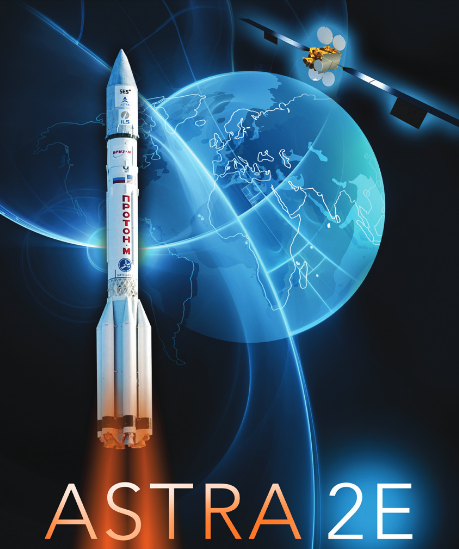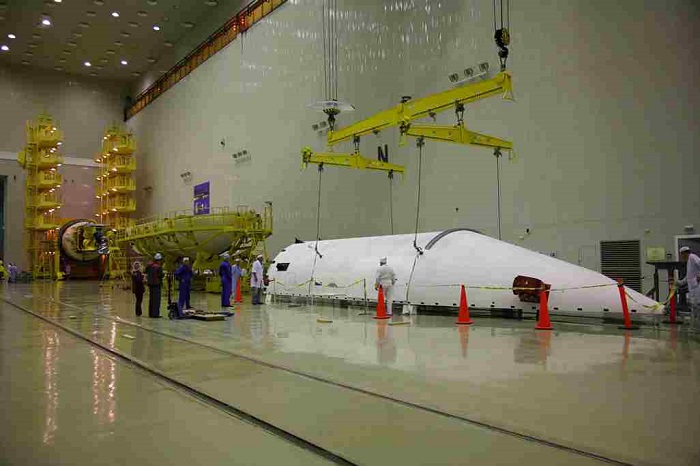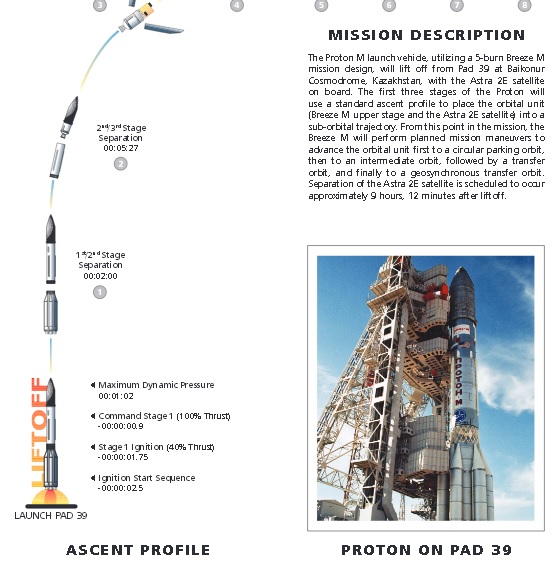.

54.SES-Satellit soll von einer ILS Proton in den Orbit gebracht werden
Luxemburg, 27. September 2013 - SES S.A. (NYSE Euronext Paris und Luxemburger Börse: SESG) teilt mit, dass der Satellit ASTRA 2E am 30 September 2013 an Bord einer ILS-Trägerrakete vom Typ Proton vom Weltraumbahnhof Baikonur in Kasachstan ins All starten wird. Proton soll um genau 03:38 (Ortszeit Baikonur) abheben (d.h 23:38 MESZ am 29. September).
ASTRA 2E wurde für SES von Astrium in Frankreich gebaut. Der auf der überaus zuverlässigen Plattform Eurostar E3000 basierende Satellit ist mit 60 Ku-Band-Transpondern sowie 4 Ka-Band-Transpondern ausgestattet. Er wird die Verbreitung von Rundfunk- und Breitbanddiensten der nächsten Generation in Europa, im Nahen Osten und Afrika von dem Orbitalbogen 28,2°/28,5 Ost aus ermöglichen. ASTRA 2E hat eine Startmasse von 6 Tonnen, eine Spannweite von 40 Metern (nach Entfalten der Solarpanel im Orbit) und eine Leistung von 13 kW am Ende seiner auf 15 Jahre ausgelegten Lebensdauer.
Nachdem SES-6 im Juni 2013 und ASTRA 2F im September 2012 erfolgreich gestartet wurden, wird der ASTRA 2E nun der siebte Eurostar-Satellit in der SES-Flotte sein.



Eurostar E3000 Platform
Separated spacecraft mass: 6,020 kg
Launch Vehicle:
Proton M/Breeze M
705,000 kg (1,554,000 lb), including payload
58.2 m (191ft)
Launch Date:
September 30, 2013
Launch Time:
03:38:10 Baikonur
01:38:10 Moscow
23:38:10 Luxembourg (Sept. 29)
21:38:10 GMT (Sept. 29)
17:38:10 EDT (Sept. 29)
Launch Site:
Baikonur Cosmodrome, Kazakhstan
Launch Pad 39
Launch Customer:
SES, Luxembourg
Satellite Manufacturer:
Astrium
Launch Vehicle Manufacturer:
Khrunichev State Research and Production Space Center, Russia
Launch Services Provider:
International Launch Services, USA
Satellite Use:
ASTRA 2E will carry Ku- and Ka-band payloads for the delivery of high-performance Direct-to-Home (DTH) and next generation broadband services in Europe, Middle East and Africa. Built by Astrium, ASTRA 2E will bring replacement and growth capacity at 28.2° East to enhance SES’ fleet of over 50 geostationary satellites, and ensure reliable and secure connectivity to over 99% of the world’s population.
Satellite Statistics:
__60 Ku-band transponders
__4 Ka-band transponders (of which 1 is interconnected)
__Planned location: 28.2° orbital neighborhood
__Anticipated service life: 15 years
Mission Profile:
The Proton M launch vehicle, utilizing a 5-burn Breeze M mission design, will lift off from Pad 39 at Baikonur Cosmodrome, Kazakhstan, with the ASTRA 2E satellite on board. The first three stages of the Proton will use a standard ascent profile to place the orbital unit (Breeze M Upper Stage and the ASTRA 2E satellite) into a sub-orbital trajectory. From this point in the mission, the Breeze M will perform planned mission maneuvers to advance the orbital unit first to a circular parking orbit, then to an intermediate orbit, followed by a transfer orbit, and finally to a geosynchronous transfer orbit. Separation of the ASTRA 2E satellite is scheduled to occur approximately 9 hours, 12 minutes after liftoff.
Target Orbit at Separation:
Perigee: 4,202 km
Apogee: 35,736 km
Inclination: 23.0 degrees
Spacecraft Separation:
Approximately 9 hours, 12 minutes after liftoff
ILS Mission Statistics:
_5th ILS Proton Launch in 2013
_82nd ILS Proton Launch Overall
_23rd SES Satellite Launched on ILS Proton
_17th Astrium Satellite Launched on Proton
.

.

.
Quelle: ILS
.
Update: 29.09.2013
.
Proton-M Poised for Return to Flight Mission Sunday Night

Laden with the Astra 2E communications satellite, Russia’s giant Proton-M is rolled horizontally to Pad 39 at Site 200 at Baikonur on Thursday, 26 September. Photo Credit: ILS
.
Less than three months after the spectacular—though catastrophic—loss of a Proton-M booster in July, International Launch Services (ILS) is primed to return the venerable vehicle to flight. Liftoff of the three-stage Proton and its troubled Briz-M upper stage from Pad 39 at Site 200 at the Baikonur Cosmodrome in Kazakhstan is scheduled for 2:38 a.m. local time Monday (4:38 p.m. EDT Sunday), carrying the Astra 2E communications satellite into 22,300-mile geosynchronous orbit. The 174-foot-tall Proton was rolled horizontally out to the launch pad on Thursday, 26 September and raised into a vertical orientation, with propellant loading operations slated for early Sunday.
Quelle: ILS
.
Update: 22.15 MESZ

.

.

.

FRAMS: LIVE ILS

.


Quelle: ILS
.
Update: 30.09.2013
.
Russia’s Proton rocket successfully lifts off from Baikonur

